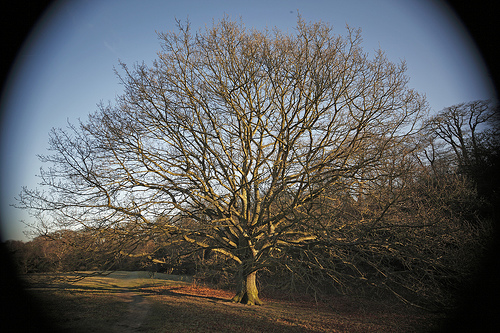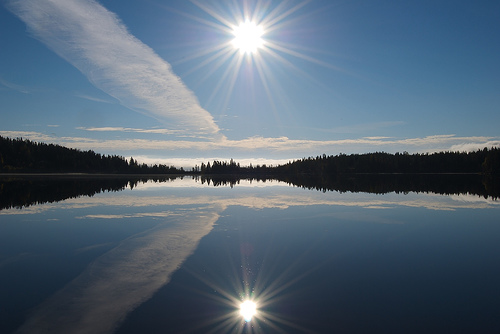The camera aperture is one element in the camera which perhaps has the most effects on your picture. Here’s a collection of some of these effects caused by the lens aperture. So the next time you use a wide or a small aperture, know that you are not changing the exposure.
-
Depth Of Field And Aperture
The primary purpose of aperture settings on the camera is to attain depth of field. The depth of field refers to the area of sharp focus in a photograph. The aperture plays an important role in determining the depth in the composition. The smaller the aperture, more is the depth in the composition thus, putting everything in sharp focus. On the other hand, a wider aperture enables you to achieve a shallow DOF — effectively focused subject amidst defocused background and the foreground.
-
Aperture Is Used For Creating Beautiful Bokeh
Bokeh is the terminology for the aesthetic blur achieved at shallow depth of field. Bokeh is the the way the lens renders out-of-focus points of light. When the camera is tuned for shallow dof and there is an effective brightness in the background of the subject (due to lights and reflections), the camera lens renders beautiful imagery of the out-of-focus points termed bokeh. DOF and the bokeh are two different things. Check out the difference between the bokeh and DOF here.
-
Aperture Is Not Used For Exposure
As contradictory as it sounds, aperture is not used to control the exposure. Not until you set the camera to fully manual mode. On other modes like the aperture priority mode, the fine-tuning the aperture helps in achieving the desired depth of field. The aperture priority mode offered by the camera is a semi-auto mode. Thus, when the user fine-tunes the aperture, the camera intelligently handles the rest of settings (like shutter-speed and even ISO) for ensuring proper exposure for the scene.
-
Chromatic Aberration Is Not An Aperture Effect
The chromatic aberration distorts the color information of the image by producing the fringes of colors along the boundaries that separate dark and bright parts of the image. The chromatic aberration is caused due to the failure of a lens to focus all colors to the same convergence point and not because of in-optimal aperture. The chromatic aberration is not a side-effect of a small aperture but of the lens optics viz. glass.
-
Aperture Can Be Used For Vignetting Effect
Vignetting is the technique of reducing the brightness of image at the edges, so as to draw the viewer’s attention to the center of the frame. At other times it is considered an unwanted artifact. The vignetting effect can be achieved by using the special lenses (or filters) and also during post-processing.
When a photographer uses the special lenses for creating the vignetting effect in camera, the aperture plays a crucial role in darkening the edges. The darkening can be gradual or abrupt, depending on the lens aperture. The smaller the aperture, the more abrupt the vignetting as a function of angle. On the other, there are some lenses which produce undesirable vignetting effect, which can be controlled or completely cured by a reduction in aperture of 2–3 stops.
-
Aperture Results In Loss Of Sharpness
When you are using a wide aperture, the depth of filed is very limited. The areas in the background and foreground of the focal plane will be blurred. As you close down to a smaller aperture, diffraction rolls in killing the sharpness.
-
Diffraction Spikes On Small Apertures
On smaller apertures the diffraction becomes increasingly prominent. This can be used for some very creative effects. This diffraction spike can be used as a creative technique while photographing the lights (or any source of light for that matter) to get the star-light effect. You can generate the star lights by resting the camera on the tripod, focusing on lights and tuning the camera to a very small aperture. This results in scattering of lights from the light source, forming beautiful star like formations of the diffracted lights.
-
Understand The Optimal Aperture
Optimal aperture is the point beyond which the image-sharpness reduces and the impact of diffraction becomes profound. The optimal aperture varies with the camera lens and you will have to run your own tests to figure out the sharpest aperture.
What other effects of aperture do you notice?






If you’re going to talk about differences between “theory and the real,” you could do better than to lead people into thinking that they can’t control CA with aperture. Stopping down is a proven method of decreasing CAs. Yes, buy a better lens by all means – but since you linked Ken Rockwell: “Your Camera Doesn’t Matter.” It’s best to use the camera you have, and the lens you have, flaws and all. We can always lust after better glass, but people back in the days of poor lenses made do, and (usually) so can we!
Onto your second point, let me explain myself more clearly. Here is the equation, universally recognized by optic scientists and serious photographers worldwide, for exposure:
H = Et
H is defined as the exposure (the total quantity of illuminated light), E is the illumination coming into the image plane (at any given point of time), and t is, of course, time. Lux * seconds = Lux-seconds (or esposure).
A fun but surprisingly accurate analogy: When we say somebody died of exposure, we don’t say they died because they stood in the door of an igloo for a few hours. We say they died because they were exposed to the cold for those few hours – the aperture of their dwelling is vitally important in this case! (On the other hand, the people on the Space Shuttle will get very hot very quickly if there is no way to radiate the heat they generate outwards at the rate it is generated – sort of like a big, white, spacefaring igloo with no door at all – as there usually is when you are surrounded by a fluid e.g. Earth’s Atmosphere, but since that gets into radiant heat I’ll stop there.)
Let me repeat: Exposure is the combination of the amount of light, which is controlled by your aperture, multiplied by the time you expose your medium to that light. When I open up the aperture, I’m allowing more light to fall onto the sensor. For the same amount of time, the image gets more exposed.
I kind of get what you’re trying to say here but it is simpler to work with the actual model, rather than trying to protect people from what that actual model is.
About camera modes I will simply say that, in practice (again, this isn’t at all incompatible with the real world), with fixed sensitivity film (or sensors) you often have to make a tradeoff between shutter speed and depth of field effects (I caught myself writing “brightness,” which of course is instead a function of the total exposure). When the image comes out under- or over- exposed, you still do have control over aperture in Tv mode, and you still have control over shutter speed in Av mode, by using exposure compensation. Then, to avoid high ISO noise you can push brightness up in your post-production.
As a parting comment – yes, cameras can hide a lot of the actual workings of photography from the novice. But, as your article attempts to illustrate, the actual effects of varying aperture and shutter speed are very different, so for a photographer to really gain control over their photographs they have to understand that those two elements work together and they have to understand that you cannot just use one.
My personal method is simply, when possible, to decide what I want to prioritize: Aperture (either a smaller aperture for increased sharpness and decreasing other unwelcome effects of the lens – yes, including CA, or a larger aperture for depth of field effects) or shutter speed. If the other value gets too far out of balance from where I need it to be, I typically use Exposure Compensation to adjust the camera’s target exposure – either lighter or darker than it normally attempts to expose. Is this “direct” control over the other value? No. Does this matter? No, because otherwise you’re, as you say, using Manual and not taking advantage of the camera’s specific autoexposure features.
And on that note, here’s my own tip: When you want to isolate and highlight a white object in a busy scene (say a somewhat dark forest) you can simply set the camera to one of the priority modes, and then dial exposure compensation down. The surroundings get darker, but white tends to stay white. Simple!
Best of luck!
Sadly your comment was more of nit-picking on established practices. Your last comment is eventually reiterating what’s said in the article.
“CA is not an aperture effect”… simply means aperture is not the root of the problem, the glass is. I do not and cannot lead people into thinking what they or what they can’t do, I only mention the obvious scientific findings.
The problem with photographers is that they blow exposure our of proportion. And the entry level people find it just too difficult to cope with the complications of the exposure. Here’s my tip: use the auto mode. You shouldn’t need to worry about exposure in 2011 in 90% of the situations.
Half the world believes they are controlling exposure in Av/A-priority or the Tv/S-priority mode. They simply fail to read the camera manual.
An article of this level assumes that the reader and the author are on the same page whereas the basic definitions of aperture, exposure etc. are concerned. So if they want to read about what aperture-priority does, they can read my previous articles discussing camera modes https://www.apnphotographyschool.com/digital-camera-modes/. We’ve discussed the exposure model in detail in one of our previous articles too. So an article which talks about aperture effects does not have to be all inclusive of the definitions of these terms and by no means needs to quote scientific equations and defend oneself like a lawyer. You agree that you do not use aperture-priority (or aperture) to control the exposure (bar the M mode). What you’ve stated about exposure is obvious, established and covered in our article on exposure https://www.apnphotographyschool.com/secrets-exposure/. So we are not working without the actual model or trying to hide it, we are trying to say what it is and what it is not. We’ve also covered the effects of varying aperture, shutter-speed and ISO in various articles previously so this article has been built on already covered and established framework and must be interpreted in that context.
I hope you enjoy being a part of the APN community, we have readers of all levels of knowledge and we try to keep topics uncomplicated and focus on one thing at a time. Hope you’d agree with this approach. Our past articles stand testimony to the fact that the information is thoroughly researched upon and is open to constructive discussions. Thanks for the tip in your last comment.
Wish you all the best!